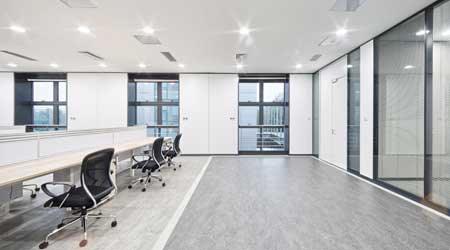 The acoustical quality of an open workplace is shaped by a wide range of building elements, including the type of ceiling, whether sound masking is being used, the type of partitions between workstations, if any, and how much exposed hard surface area there is.
The acoustical quality of an open workplace is shaped by a wide range of building elements, including the type of ceiling, whether sound masking is being used, the type of partitions between workstations, if any, and how much exposed hard surface area there is.How to Improve Acoustics in an Open Office
Software and sound masking for controlling the acoustical environment have improved tremendously in recent years.
To ensure an optimal level of both speech privacy and speech intelligibility in work environments, facility managers need to stay on top of how acoustical products are being refined by the sound-management industry. These companies are always working to deliver better products to market, but facility managers need some knowledge of what's available to make good choices.
High-level sound masking technology is being improved with systems that are “more flexible, precise, and accountable than ever before," says Niklas Moeller, vice president of K.R. Moeller Associates, which manufactures LogiSon acoustics products.
But how can facility managers measure the performance of a sound masking system? Facility managers often cannot subjectively tell whether a sound masking system they have been using, or one that they are buying, is doing its job, says Moeller.
“It’s easy to hear whether there is sound in the space, but difficult to tell whether it is as effective as it should be or not,” says Moeller.
New software technology is available that tunes every small zone in a facility and then delivers a report of the outcome showing what has been specified for that space (for example, the masking curve and masking volume) and whether measured results are meeting the specified bar. Thus, users can rely on metrics rather than just trust that the sound masking system is doing what it is supposed to do.
“That’s important because even small variations, such as a slight loss of volume, have a significant impact on speech intelligibility and privacy and focus,” Moeller says.
Speaker monitoring allows a user to know when service is required because of a speaker failure or inadvertent damage that may be done to equipment during building maintenance.
“Even during installation, speaker monitoring is an excellent way to verify that third-party installers have put everything where it is supposed to be,” Moeller says.
Controlling the sound
The ability to control sound within smaller spaces has become more refined in the past few years. Technology platforms that allow people to connect and control sound masking systems continue to evolve, says David Smith, vice-president of marketing at Lencore.
Cloud-based technology is creating more security “on the back end of the infrastructure and improving users’ ability to control systems from a laptop or tablet,” Smith says. “We have the ability to make adjustments to any facility, no matter where you are located, as long as you are on the network. This is now a cloud-based system, which IT departments in particular find to be a more secure avenue in terms of connectivity.
Networked sound masking can be used with both direct and indirect systems and allows for more individual control, so each speaker on a network can be tuned or adjusted in that environment, says Nathan Van Ness, product marketing manager at Biamp.
Networking is particularly helpful when a plenum is packed with items such as HVAC ducts or old pipes that can affect sound. A networked system in an indirect sound masking environment allows for fine tuning to “compensate for those acoustic variables,” says Van Ness. While the volume can be adjusted, changes will still be consistent across the network. With direct field emitters, users can “attenuate each one in small decibel increments,” but once they are set, sound is raised or lowered across the entire system with no individual tuning, says Van Ness.
Multi-tasking with mass communication
Today, companies may integrate their sound masking systems with mass communication systems.
"If you can leverage a system that does sound masking, paging, and background music all in one, you don't have to buy multiple systems,” says Smith. “But you need enough power to drive a page, which requires more energy than sound masking."
Products that do sound masking and mass communication may provide convenience, but quality may be less than desired. Facility managers may want to consider separate systems so both emergency communication and sound masking needs are met.
“Usually when you do both systems together, the sound masking performance suffers," says Moeller.
When the two functions are merged, masking zones tend to increase, which is not optimal.
"There are perfectly good standalone options that can be implemented for a mass notification system, which is clearly of utmost importance in the moment when you need it,” says Moeller. “But if you talk about downgrading performance you use every day, then convergence is not a smart move.”
Related Topics:














